Bookmobile
A bookmobile or mobile library is a vehicle designed for use as a library. They have been known by many names throughout history, including traveling library, library wagon, book wagon, book truck, library-on-wheels, and book auto service.[1] Bookmobiles expand the reach of traditional libraries by transporting books to potential readers, providing library services to people in otherwise underserved locations (such as remote areas) and/or circumstances (such as residents of retirement homes). Bookmobile services and materials (such as Internet access, large print books, and audiobooks), may be customized for the locations and populations served.
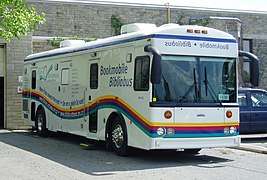
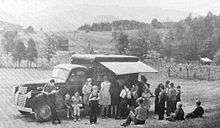
Bookmobiles have been based on various means of conveyance, including bicycles, carts, motor vehicles, trains, watercraft, and wagons, as well as camels, donkeys, elephants, horses, and mules.[1]
History
19th century

In the United States of America, The American School Library (1839) was a traveling frontier library published by Harper & Brothers. The Smithsonian Institution's National Museum of American History has the only complete original set of this series complete with its wooden carrying case.[2]
The British Workman reported in 1857[3] about a perambulating library operating in a circle of eight villages, in Cumbria. A Victorian merchant and philanthropist, George Moore, had created the project to "diffuse good literature among the rural population".[4]
The Warrington Perambulating Library, set up in 1858, was another early British mobile library. This horse-drawn van was operated by the Warrington Mechanics' Institute, which aimed to increase the lending of its books to enthusiastic local patrons.[5]
20th century
One of the earliest mobile libraries in the United States was a mule-drawn wagon carrying wooden boxes of books. It was created in 1904 by the People's Free Library of Chester County, South Carolina, and served the rural areas there.[6]
Another early mobile library service was developed by Mary Lemist Titcomb[7] (1857–1932).[8] As a librarian in Washington County, Maryland, Titcomb was concerned that the library was not reaching all the people it could. The annual report for 1902 listed 23 "branches", each being a collection of 50 books in a case that was placed in a store or post office throughout the county.[9] Realizing that even this did not reach the most rural residents, the Washington County Free Library began a "book wagon" in 1905, taking the library materials directly to people's homes in remote parts of the county.[10]
With the rise of motorized transport in America, a pioneering librarian in 1920 named Sarah Byrd Askew began driving her specially outfitted Model T to provide library books to rural areas in New Jersey.[11] The automobile remained rare, however, and in Minneapolis, the Hennepin County Public Library operated a horse-drawn book wagon starting in 1922.[12]
Following the Great Depression in the United States, a WPA effort from 1935 to 1943 called the Pack Horse Library Project covered the remote coves and mountainsides of Kentucky and nearby Appalachia, bringing books and similar supplies on foot and on hoof to those who could not make the trip to a library on their own. Sometimes these "packhorse librarians" relied on a centralized contact to help them distribute the materials.[13]
At Fairfax County, Virginia, county-wide bookmobile service was begun in 1940, in a truck loaned by the Works Progress Administration ("WPA"). The WPA support of the bookmobile ended in 1942, but the service continued.[14]
The "Library in Action" was a late-1960s bookmobile program in the Bronx, NY, run by interracial staff that brought books to teenagers of color in under-served neighborhoods.[15]
Bookmobiles reached the height of their popularity in the mid-twentieth century.[16]
21st century
Bookmobiles are still in use in the 21st century, operated by libraries, schools, activists, and other organizations. Although some feel that the bookmobile is an outmoded service, citing reasons like high costs, advanced technology, impracticality, and ineffectiveness, others cite the ability of the bookmobile to be more cost-efficient than building more branch libraries would be and its high use among its patrons as support for its continuation.[17] To meet the growing demand for "greener" bookmobiles that deliver outreach services to their patrons, some bookmobile manufacturers have introduced significant advances to reduce their carbon footprint, such as solar/battery solutions in lieu of traditional generators, and all-electric and hybrid-electric chassis. Bookmobiles have also taken on an updated form in the form of m libraries,[18] also known as mobile libraries[19] in which patrons are delivered content electronically.[20]
The Internet Archive runs its own bookmobile to print out-of-copyright books on demand.[21] The project has spun off similar efforts elsewhere in the developing world.[22]
The Free Black Women's Library is a mobile library in Brooklyn. Founded by Ola Ronke Akinmowo in 2015, this bookmobile features books written by black women. Titles are available in exchange for other titles written by black female authors.[23]
National Bookmobile Day
In the U.S., the American Library Association sponsors National Bookmobile Day in April each year, on the Wednesday of National Library Week.[24][25]
Countries
Africa
- In Kenya, the Camel Mobile Library Service is funded by the National Library Service of Kenya and by Book Aid International and it operates in Garissa and Wajir, near the border with Somalia. The service started with three camels in October 1996 and had 12 in 2006, delivering more than 7,000 books[26] —in English, Somali, and Swahili.[27] Masha Hamilton used this service as a background for her 2007 novel The Camel Bookmobile.[28]
- "Donkey Drawn Electro-Communication Library Carts" were being employed in Zimbabwe in 2002 as "a centre for electric and electronic communication: radio, telephone, fax, e-mail, Internet".[29]
Asia
.jpg)
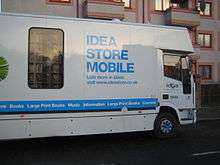
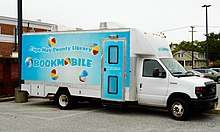
- In Bangladesh Bishwo Shahitto Kendro pioneeredthe concept of mobile library. Mobile library was introduced in Bangladesh in 1999.Then the service was limited to Dhaka, Chattogram, Khulna and Rajshahi only .Now the service is available in 58 districts of the country.There are about 330000 registered users of this library. These mobile libraries together gives the service of 1900 small libraries in 1900 localities of the country.
- In Indonesia in 2015, Ridwan Sururi and his horse "Luna" started a mobile library called Kudapustaka (meaning "horse library" in Indonesian). The goal is to improve access to books for villagers in a region that has more than 977,000 illiterate adults. The duo travel between villages in central Java with books balanced on Luna's back. Sururi also visits schools three times a week.[31]
- In Thailand in 2002, mobile libraries were taking several unique forms.[32]
- Elephant Libraries were bringing books as well as information technology equipment and services to 46 remote villages in the hills of Northern Thailand. This project was awarded the UNESCO International Literacy Prize for 2002.
- A Floating Library had two book boats, one of which was outfitted with computers.
- A three-car "Library Train for Homeless Children" (parked in a siding near the railway police compound) was a "joint project with the railway police in an initiative to keep homeless children from crime and exploitation by channeling them to more constructive activities". The train was being replicated in "a slum community in Bangkok", where it, too, would include a library car, a classroom car, and a computer and music car.
- Book Houses were shipping containers fitted out as libraries with books. The 10 original Book Houses were so popular, another 20 units were already being planned.
- In India, the Boat Library Services were operated under the auspices of the Andhra Pradesh Library Association, Vijayawada, Andhra Pradesh State.Paturi Nagabhushanam initiated boat libraries to inculcate interest in reading of books and libraries among the rural public in 1935 October, as an extended activity of Andhra Pradesh Library Movement. He had run this service for about seven years to benefit the villagers travelling on boats, which was a major travel and transportation facility available in those days. These libraries facilitated Telugu literary journals and books.,[33][34]
Australia
- The First bookmobile in the State of Victoria was operated by Heidelberg Library (now Yarra Plenty Regional Library) in the City of Heidelberg, Melbourne in 1954.[35]
Europe
- In Glasgow, Scotland, in 2002, MobileMeet—a gathering of about 50 mobile libraries that was held annually by the IFLA—there were "mobiles from Sweden, Holland, Ireland, England, and of course Scotland. There were big vans from Edinburgh and small vans from the Highlands. Many of the vans were proudly carrying awards from previous meets."[32]
- Since 1953, the Libraries of the Community of Madrid, Spain, have operated a bibliobus program with books, DVDs, CDs, and other library materials available for checkout.[36][37]
- A floating library, aboard the ship Epos, was begun in 1959 and serves the many small communities on the coast of Western Norway.
- In Estonia, the bookmobile "Katarina Jee" has been running since 2008, serving patrons in suburbs of Tallinn.
- In Finland, the first mobile library was established in Vantaa in 1913.[38] There are currently about 200 bookmobiles in Finland, operating across the country.
North America
- Street Books is a nonprofit book service founded in 2011 in Portland, Oregon, that travels via bicycle-powered cart to lend books to "people living outside".[39]
- Books on Bikes[40] is a program begun in 2013 by the Seattle Public Library that uses a customized bicycle trailer pulled by pedal power to bring library services to community events in Seattle.[41]
- The Library Cruiser is a "book bike" from the Volusia County Libraries that debuted in Florida in September 2015. Library staff ride it to various locations, offering library books for checkout, as well as WiFi service, ebook access help, and information on obtaining a library card.[42]
South America
- The Biblioburro is a mobile library by which Colombian teacher Luis Soriano and his two donkeys, Alfa and Beto, bring books to children in rural villages twice a week. CNN chose Soriano as one of their 2010 Heroes of the Year.[43]
Gallery
- Mobile libraries around the world
- Brazil - 2011
 Brazil - 2017
Brazil - 2017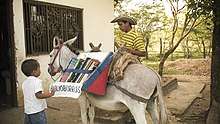 Colombia - 2006
Colombia - 2006
Biblioburro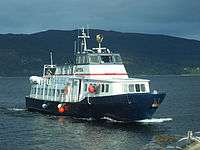 Norway - 2011
Norway - 2011
Epos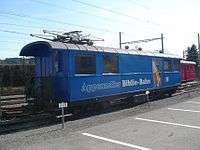 Switzerland - 2007
Switzerland - 2007.jpg) Fresno County, California (United States) - 2019
Fresno County, California (United States) - 2019
References
- Bashaw, Diane (2010). On the Road Again: A Look at Bookmobiles, Then and Now. Children & Libraries: The Journal of the Association for Library Service to Children. p. 33.
- Olmert, Michael (1992). "The Infinite Library, Timeless and Incorruptible". The Smithsonian book of books (1. ed.). Washington, D.C.: Smithsonian Books. ISBN 0-89599-030-X.
- "Perambulating Library". The British Workman. February 1, 1857.
- "George Moore". Mealsgate.com. Retrieved 1 September 2011.
- Orton, Ian (1980). An Illustrated History of Mobile Library Services in the UK with notes on traveling libraries and early public library transport. Sudbury: Branch and Mobile Libraries Group of the Library Association. ISBN 0-85365-640-1.
- "History". Chester County Free Public Library. Retrieved 1 May 2010.
- "The first county bookmobile in the US, Western Maryland Regional Library". whilbr.org.
- Joanne E. Passet (1994). "Itinerating Libraries". In Wayne A. Wiegand and Donald G. Davis (ed.). Encyclopedia of Library History. Taylor & Francis. pp. 315–317. ISBN 978-0-8240-5787-9.
- Washington County Free Library. First Annual Report for the Year ending October 1, 1902.
- Maryland State Archives. "Maryland Women's Hall of Fame". Washington County Free Library.
- Susan B. Roumfort (1997). "Sarah Byrd Askew, 1877-1942". In Joan N. Burstyn (ed.). Past and Promise: Lives of New Jersey Women. Syracuse University Press. pp. 103–104. ISBN 9780815604181.
- Ehling, Matt (30 June 2011). "The Hennepin County Library system – connecting past with present". MinnPost (Politics and Policy). Archived from the original on 27 March 2018. Retrieved 26 March 2018.
- WPA (July 2012). "Packhorse Librarians in Kentucky, 1936-1943" (PDF). University of Kentucky.
- Barbuschak, Christopher, Virginia Room Archivist/Librarian, City of Fairfax Regional Library, Statement by E-Mail, sent Thursday, August 16, 2018 10:56:52 PM:[...]"in a history book entitled Fairfax County VA A History. On page 618, we found this sentence: "Herndon's Fortnightly Club established a library in 1889, and for many years this facility and the county's bookmobiles were the only library services available in the northwestern part of the county." Fairfax County did not have bookmobiles until 1940. " [...]
- Attig, Derek (12 April 2012). "National Bookmobile Day: Aggregation Edition". HASTAC.
- Berger, M. (1977). Reading, Roadsters, and Rural America. The Journal of Library History (1974-1987), 12(1), 42-49. JSTOR 25540714
- Bashaw, D. (2010). "On the road again: A look at bookmobiles, then and now" (PDF). Children & Libraries. 8 (1). pp. 32–35. Archived from the original (PDF) on 2014-11-09. Retrieved 2014-11-12.
- "Se connecter - ProQuest" (in French). ProQuest 875711389. Cite journal requires
|journal=(help) - Want, Penny (1990). "The history and development of mobile libraries". Library Management. 11 (2): 5–14. doi:10.1108/EUM0000000000825. ProQuest 57089094.
- Brena Smith; Michelle Jacobs (18 May 2010). "Libraries and patrons on the move: from bookmobiles to "m" libraries". Reference Services Review. 38 (2). doi:10.1108/rsr.2010.24038baa.002. ISSN 0090-7324.
- Jeffrey Schnapp; Matthew Battles (2014). Library Beyond the Book. Harvard University Press. ISBN 978-0-674-72503-4.
- "Bookmobile". The Internet Archive.
- Atwell, Ashleigh (28 February 2018). "Bed-Stuy Pop-Up Library Focuses On Black Women Writers". Bed-Stuy, NY Patch. Retrieved 3 October 2018.
- "National Bookmobile Day". ALA.
- ALA. "Bookmobiles". Pinterest.
- "Kenya's children of the desert". Guardian Unlimited. 1 December 2005. Retrieved 1 June 2007.
- "Camel Library Service". Kenyan Camel Book Drive. Retrieved 1 June 2007.
- Hamilton, Masha (1 January 2007). The Camel Bookmobile: A Novel (1st ed.). New York: HarperCollins. ISBN 9780061173486. LCCN 2006041316.
- "Donkeys help provide Multi-media Library Services". IFLAnet (International Federation of Library Associations and Institutions). 25 February 2002. Retrieved 26 March 2018.
- "Mobile Libraries". Lincolnshire County Council. Archived from the original on 11 November 2013. Retrieved 22 November 2013.
- "The Indonesian horse that acts as a library". BBC News. 6 May 2015.
- "Mobile Section" (PDF). IFLA Newsletter (1). Autumn 2002.
- http://www.apla.co.in/the-firsts-of-andhra-pradesh-library-association/
- https://www.thehindu.com/news/cities/Vijayawada/he-kept-library-movement-afloat/article5916193.ece
- "Bookmobile to Aid Heidelberg Readers". Age (Melbourne, Vic. : 1854 - 1954). 1954-05-12. p. 9. Retrieved 2020-06-03.
- "Bibliobuses: La biblioteca móvil - Historia". Bibliotecas de la Comunidad de Madrid. Retrieved 26 March 2018.
- "La biblioteca móvil". Madrid.org. Comunidad de Madrid [city government]. 2015. Retrieved 15 July 2015.
- Kyöstiö, Antero (2004). "Kirjastoautohistoria". Kirjastot.fi (in Finnish). Retrieved 2019-07-30.
Suomen ensimmäinen liikkuva kirjasto toimi nykyisen Vantaan kaupungin, entisen Helsingin maalaiskunnan, alueella 1913-14.
- Johnson, Kirk (9 October 2014). "Homeless Outreach in Volumes: Books by Bike for 'Outside' People in Oregon". The New York Times.
- "Books on Bikes". The Seattle Public Library. Archived from the original on 27 March 2018. Retrieved 26 March 2018.
- "Books on Bikes Helps Seattle Librarians Pedal To The Masses".
- "Volusia County Libraries Have a Book Bike!" (PDF). Friends of the Daytona Beach Regional Library Newsletter. 1 March 2016. Retrieved 26 March 2018.
- "Luis Soriano". The Gallery of Heroes. CNN. November 2014.
Further reading
- Finnell, Joshua. "The Bookmobile: Defining the Information Poor". MSU Philosophy Club. An article on the history of the bookmobile in the US.
- King, Stephen (2011). "The Magic of the Bookmobile, Take Two". Read All Day. Archived from the original on 2016-03-04. Retrieved 2015-03-19.
- Moore, Benita (1989). A Lancashire Year. Preston: Carnegie Publishing. Based on experiences while working on the Lancashire County Library mobile library service in the 1960s.
- Nix, Larry T. (ed.). "A Tribute to the Bookmobile". Library History Buff. USA.
- Ortwein, Orty (ed.). "Bookmobiles: a History". Wordpress.
- Stringer, Ian (2001). Britain's Mobile Libraries. Appleby-in-Westmorland: Trans-Pennine Publishing in association with Branch & Mobile Libraries Group of the Library Association. ISBN 1-903016-15-0.
- Stringer, Ian (coordinated by) (2010). Mobile Library Guidelines. Paris: IFLA. ISBN 978-90-77897-45-4. ISSN 0168-1931.
![]()